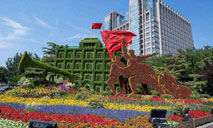Bullet train debuts on new railway in Tibet
LHASA, June 25 (Xinhua) -- The first electrified railway in southwest China's Tibet Autonomous Region opened Friday morning, linking regional capital Lhasa with the city of Nyingchi, as "Fuxing" bullet trains enter official operation on the plateau region.
With a length of 435 km and a designed speed of 160 km per hour, the new railway is a single-line electrified railway. There are currently nine stations in the cities of Lhasa, Shannan and Nyingchi that can handle passenger and freight transportation.
The newly opened Lhasa-Nyingchi railway has provided southeast Tibet with access to railway services for the first time in history.
Compared to roads, the Lhasa-Nyingchi railway reduces the travel time from Lhasa to Nyingchi from 5 hours to approximately 3.5 hours, and cuts the travel time from Shannan to Nyingchi from 6 hours to approximately 2 hours.
It is the first time that Fuxing bullet trains, which were independently developed by China, are transporting passengers in Tibet. The Fuxing bullet train series have been operating in all provincial-level regions of the Chinese mainland.
The Fuxing trains in service now have a speed range of 160 km to 350 km per hour, a notable feat in China's railway technological innovation.
The construction of the railway began in March 2015. More than 130,000 workers have been laboring in the mountains to build the railway, 90 percent of which is more than 3,000 meters above the sea level.
The rail line passes through 47 tunnels and 121 bridges, and crosses the Yarlung Zangbo River 16 times. Tunnels and bridges account for approximately 75 percent of the total length of the railway, which meant challenges for construction workers and provided valuable experience for the construction of railways on plateaus.
The railway's annual freight transport capacity of 10 million tonnes provides strong support for the flow of goods, which will promote economic development and improve people's lives.

Photos
Related Stories
- Shanghai teacher blazes new trail for Tibet students with fine art education
- Students in Tibet, south Xinjiang enjoy free education for 15 years: white paper
- Magnificent scenery of Sijinlacuo Lake in Tibet
- Former serf in Tibet embraces new life after democratic reform
- Former serf enjoys happy life in Tibet
Copyright © 2021 People's Daily Online. All Rights Reserved.










